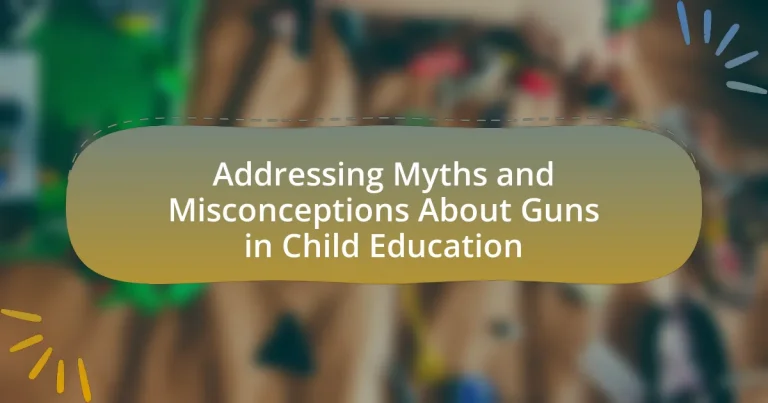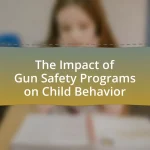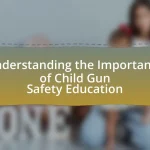The article addresses the prevalent myths and misconceptions surrounding guns in child education, emphasizing the importance of open discussions about gun safety. It highlights research indicating that educating children about firearms can reduce unsafe behaviors and foster a culture of responsibility. The persistence of these myths is attributed to cultural beliefs, misinformation, and media influence, which can lead to inadequate safety measures and heightened fear among parents and educators. The article also outlines effective strategies for integrating gun safety education into curricula, the role of community programs, and the importance of parental involvement in dispelling misconceptions.
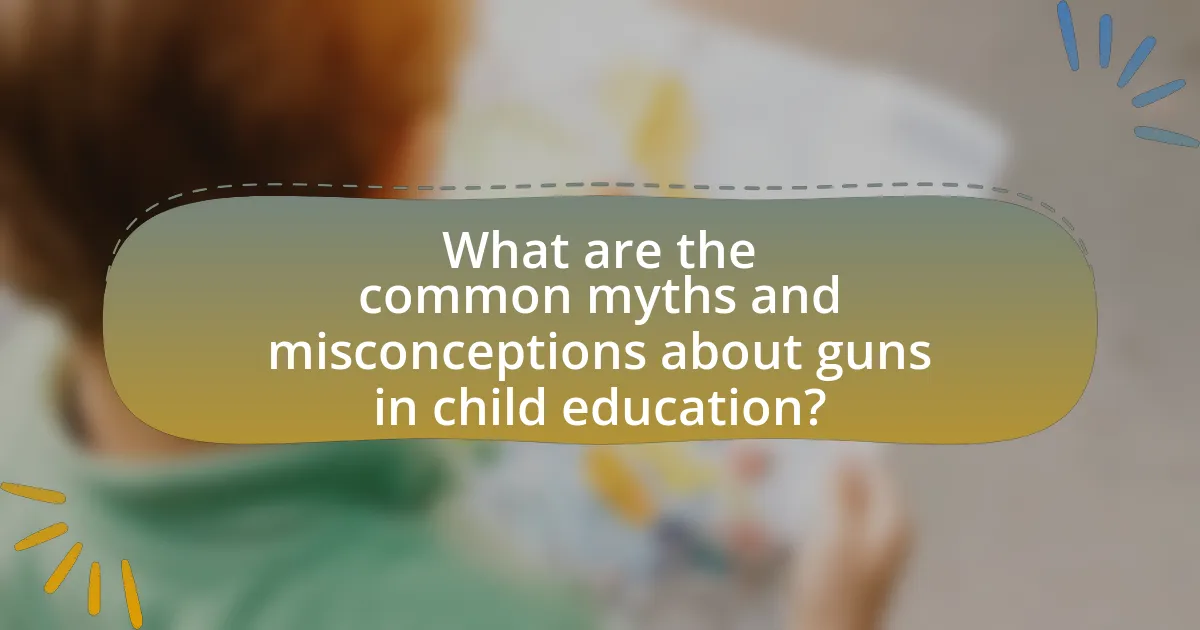
What are the common myths and misconceptions about guns in child education?
Common myths and misconceptions about guns in child education include the belief that discussing guns with children increases their curiosity and likelihood of handling firearms irresponsibly. Research indicates that open conversations about gun safety can actually reduce risks; for instance, a study published in the Journal of Pediatrics found that children who received education on gun safety were less likely to engage in unsafe behaviors around firearms. Another misconception is that children are too young to understand gun safety; however, age-appropriate education can effectively teach children about the dangers of guns and the importance of reporting them to adults. Additionally, some believe that teaching children about guns promotes violence, but evidence shows that education focused on safety and responsibility can foster a culture of respect and caution regarding firearms.
Why do these myths persist in society?
Myths about guns in child education persist in society due to a combination of cultural beliefs, misinformation, and emotional responses. Cultural narratives often glorify firearms, leading to a normalization of myths surrounding their use and safety. Misinformation spreads rapidly through social media and word of mouth, reinforcing misconceptions without factual basis. Emotional responses, particularly fear and anxiety regarding child safety, can cause individuals to cling to these myths as a means of coping, despite evidence to the contrary. Studies indicate that education and open dialogue can effectively counter these myths, yet they remain entrenched due to the aforementioned factors.
What role does media play in shaping perceptions of guns in education?
Media significantly influences perceptions of guns in education by framing narratives that shape public opinion and policy. Through news coverage, documentaries, and social media, media outlets often highlight incidents of gun violence in schools, which can lead to heightened fear and anxiety among parents and educators. For instance, a study by the Pew Research Center found that 57% of Americans believe that gun violence is a major problem in schools, largely driven by media reporting on school shootings. This portrayal can create misconceptions about the prevalence of guns in educational settings, overshadowing discussions about responsible gun ownership and safety measures. Consequently, media plays a critical role in either perpetuating myths or fostering informed dialogue regarding guns in education.
How do cultural attitudes influence beliefs about guns and children?
Cultural attitudes significantly shape beliefs about guns and children by influencing perceptions of safety, responsibility, and the role of firearms in society. For instance, in cultures where gun ownership is viewed as a fundamental right, such as in the United States, there is often a belief that children should be educated about guns for safety and responsibility, leading to programs that teach firearm safety from a young age. Conversely, in cultures with stricter gun control laws, there may be a prevailing belief that exposure to guns is inherently dangerous, resulting in a reluctance to discuss firearms with children at all. Research indicates that these cultural perspectives can lead to differing rates of gun-related accidents among children, with countries that emphasize gun safety education experiencing lower incidents compared to those that do not prioritize such education.
What are the potential consequences of these misconceptions?
The potential consequences of misconceptions about guns in child education include increased risk of accidental shootings and perpetuation of fear surrounding firearms. Misunderstandings can lead to inadequate safety measures, as parents and educators may not recognize the importance of proper gun education and storage. For instance, the American Academy of Pediatrics states that children are more likely to encounter firearms in homes where they are not properly secured, resulting in higher rates of unintentional injuries. Additionally, misconceptions can foster a culture of fear rather than informed understanding, hindering effective communication about gun safety and responsible ownership. This lack of clarity can ultimately contribute to a cycle of misinformation, making it difficult for children to learn about firearms in a safe and responsible manner.
How can misconceptions lead to fear or misunderstanding among parents and educators?
Misconceptions can lead to fear or misunderstanding among parents and educators by creating an inaccurate perception of the risks associated with guns in child education. For instance, the belief that all guns are inherently dangerous without understanding the context of responsible gun ownership can result in heightened anxiety and resistance to educational programs that include discussions about firearms. Research from the American Psychological Association indicates that misinformation can exacerbate fears, leading to a lack of trust in educators and the educational system. This fear can manifest in opposition to safety training initiatives, ultimately hindering effective communication and education about responsible gun use and safety.
What impact do these myths have on child safety and education policies?
Myths about guns significantly undermine child safety and education policies by promoting misinformation that can lead to inadequate protective measures. For instance, the belief that more guns in schools enhance safety can result in policies that prioritize armed personnel over mental health resources, which studies show are crucial for preventing violence. Research from the American Psychological Association indicates that environments perceived as unsafe due to the presence of firearms can negatively affect children’s learning and emotional well-being. Consequently, these myths can lead to policies that fail to address the root causes of violence and neglect the importance of creating supportive educational environments.
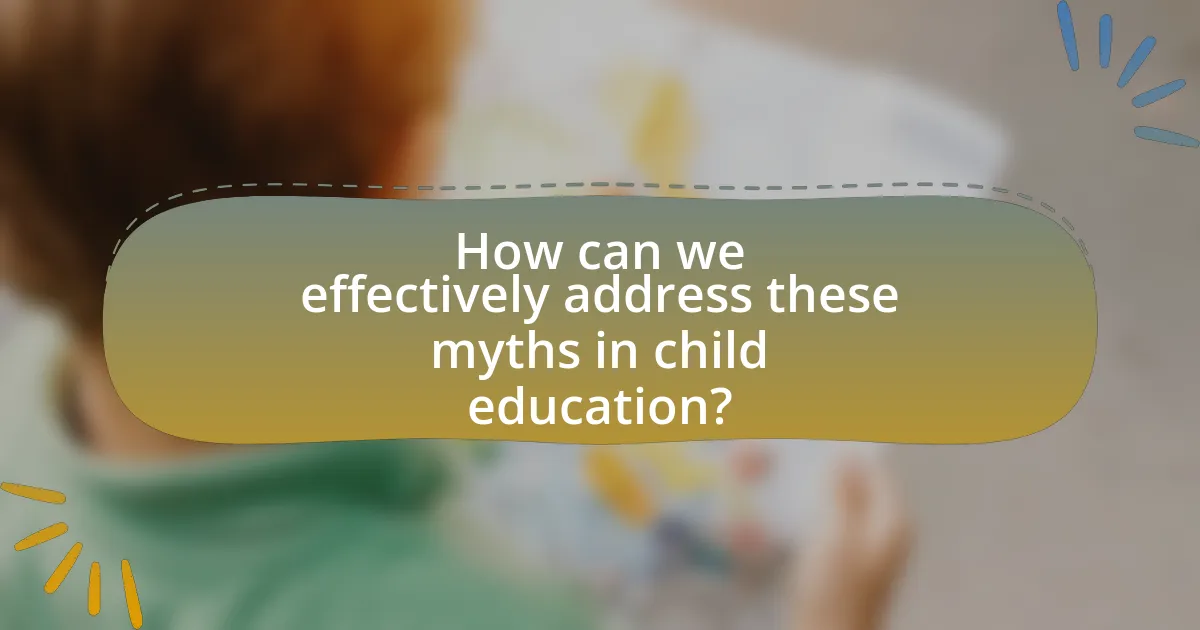
How can we effectively address these myths in child education?
To effectively address myths in child education regarding guns, educators must implement evidence-based curricula that provide accurate information about firearm safety and responsible ownership. Research indicates that comprehensive education programs, such as those developed by the National Rifle Association’s Eddie Eagle GunSafe Program, have successfully reduced misconceptions and increased awareness among children about gun safety. By integrating these programs into school curricula, educators can foster a more informed understanding of firearms, thereby dispelling myths and promoting safe practices.
What strategies can educators use to educate children about guns?
Educators can use age-appropriate discussions, interactive activities, and safety training to educate children about guns. Age-appropriate discussions involve explaining the concept of guns, their purpose, and the importance of safety in a straightforward manner. Interactive activities, such as role-playing scenarios, can help children understand how to respond if they encounter a gun. Safety training programs, like the Eddie Eagle GunSafe Program, provide structured lessons on gun safety, emphasizing the message to “Stop, Don’t Touch, Run Away, and Tell a Grown-Up.” These strategies are effective as they engage children in learning while reinforcing critical safety messages, ultimately reducing the risk of accidents and misconceptions about firearms.
How can age-appropriate discussions about guns be facilitated?
Age-appropriate discussions about guns can be facilitated by using clear, simple language tailored to the child’s developmental stage. Engaging children through storytelling or role-playing can help them understand the concepts of safety and responsibility associated with firearms. Research indicates that children as young as five can grasp basic safety rules when presented in a relatable context, such as through educational programs that emphasize non-violence and respect for life. For instance, the National Rifle Association’s Eddie Eagle GunSafe Program effectively teaches children about gun safety in a manner suitable for their age, reinforcing the importance of not touching guns and seeking adult help.
What resources are available for educators to teach about gun safety?
Educators can access various resources to teach about gun safety, including the National Rifle Association’s Eddie Eagle GunSafe Program, which provides materials for teaching children about firearm safety. Additionally, the American Academy of Pediatrics offers guidelines and resources for pediatricians and educators to discuss gun safety with families. The Centers for Disease Control and Prevention also provides educational materials focused on preventing firearm injuries among children. These resources are designed to equip educators with the necessary tools to effectively communicate the importance of gun safety to students.
How can parents contribute to dispelling these myths?
Parents can contribute to dispelling myths about guns in child education by actively engaging in open discussions with their children about gun safety and responsible ownership. By providing accurate information and context, parents can counteract misinformation that children may encounter from peers or media. Research indicates that children who receive proper education about firearms are less likely to engage in unsafe behaviors around guns. For instance, a study published in the Journal of Pediatrics found that children educated about gun safety demonstrated a 70% reduction in risky behaviors compared to those who were not educated. This highlights the importance of parental involvement in fostering a safe understanding of firearms.
What conversations should parents have with their children regarding guns?
Parents should have open and honest conversations with their children about guns, emphasizing safety, responsibility, and the realities of gun ownership. These discussions should include the importance of never touching a gun without adult supervision, understanding that guns can be dangerous, and recognizing that curiosity about guns should be addressed with facts rather than myths. Research indicates that children who receive proper education about guns are less likely to engage in risky behaviors, as highlighted in studies by the American Academy of Pediatrics, which advocate for proactive discussions about firearm safety.
How can parents model responsible attitudes towards guns?
Parents can model responsible attitudes towards guns by openly discussing gun safety and the importance of responsible ownership. Engaging children in conversations about the potential dangers of firearms, while emphasizing safe handling practices, helps instill a sense of respect and caution. Research indicates that children who receive education on gun safety from their parents are more likely to understand the risks associated with firearms and how to act responsibly around them. For instance, a study published in the journal “Pediatrics” found that children who participated in gun safety training demonstrated improved knowledge and safer behaviors regarding firearms.
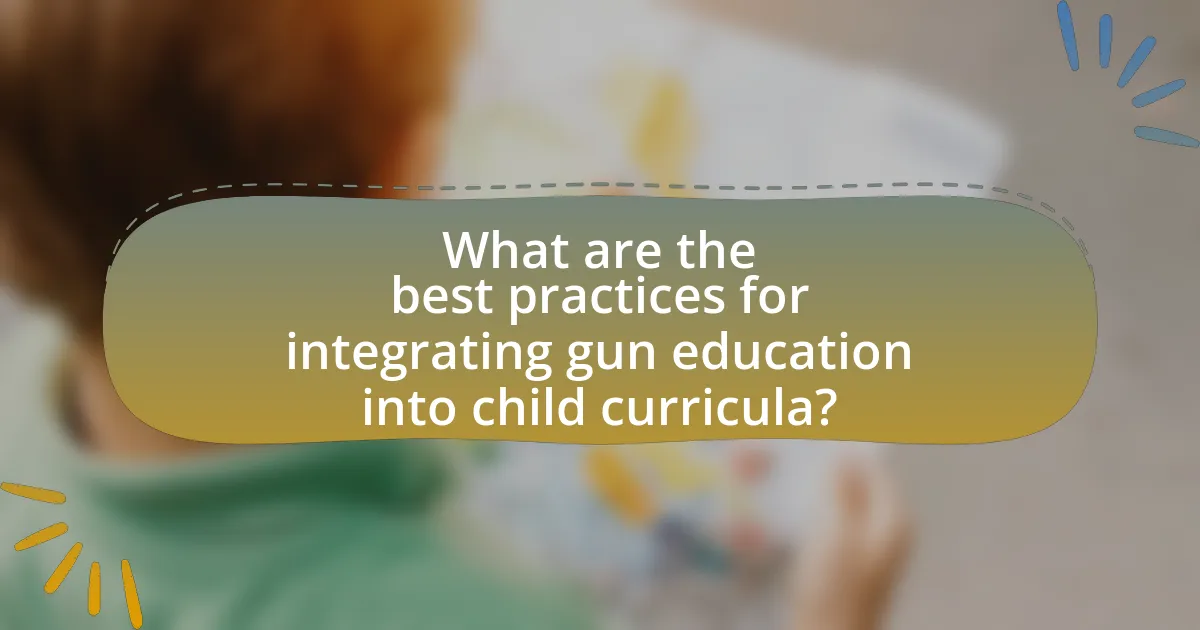
What are the best practices for integrating gun education into child curricula?
The best practices for integrating gun education into child curricula include age-appropriate content, interactive learning methods, and collaboration with experts. Age-appropriate content ensures that the information is suitable for the child’s developmental stage, which is crucial for effective learning. Interactive learning methods, such as role-playing and simulations, engage children and help them understand the implications of gun safety and responsible behavior. Collaboration with experts, such as law enforcement and educators trained in firearm safety, provides credible information and reinforces the importance of the subject. Research indicates that programs like the Eddie Eagle GunSafe Program have successfully reduced accidents by teaching children to recognize and avoid firearms, demonstrating the effectiveness of structured educational approaches.
How can schools create a safe environment for discussing guns?
Schools can create a safe environment for discussing guns by implementing structured dialogue sessions that promote open communication and respect. These sessions should include trained facilitators who can guide discussions, ensuring that all voices are heard and that the conversation remains constructive. Research indicates that environments fostering open dialogue can reduce anxiety and misconceptions; for example, a study by the National Institute of Justice found that educational programs addressing gun safety and responsible ownership can lead to improved understanding among students. Additionally, establishing clear guidelines for respectful discourse and providing resources for students to learn about gun safety can further enhance the safety of these discussions.
What policies should schools implement to support gun education?
Schools should implement comprehensive gun education policies that include age-appropriate curriculum on firearm safety, responsible ownership, and the legal implications of gun use. These policies can be supported by integrating programs such as the National Rifle Association’s Eddie Eagle GunSafe Program, which teaches children about gun safety through engaging materials. Research indicates that educational programs focused on gun safety can significantly reduce accidental shootings among children, as evidenced by a study published in the Journal of Trauma Surgery, which found a 43% decrease in firearm-related injuries in communities that adopted such educational initiatives. Additionally, schools should collaborate with local law enforcement and community organizations to provide resources and training for educators, ensuring that the information presented is accurate and relevant.
How can collaboration with law enforcement enhance educational efforts?
Collaboration with law enforcement can enhance educational efforts by providing expert insights and resources that address safety concerns related to firearms in educational settings. Law enforcement agencies can offer training programs for educators on how to handle potential threats, thereby fostering a safer learning environment. For instance, the FBI’s Active Shooter Training program equips school staff with strategies to respond effectively during emergencies, which can significantly reduce panic and confusion. Additionally, partnerships with law enforcement can facilitate community outreach initiatives that educate students and parents about gun safety, helping to dispel myths and misconceptions surrounding firearms. This collaborative approach not only improves safety protocols but also builds trust between schools and law enforcement, creating a supportive network for students and educators alike.
What role do community programs play in educating children about guns?
Community programs play a crucial role in educating children about guns by providing structured environments for learning about gun safety and responsible behavior. These programs often include workshops, hands-on activities, and discussions that demystify firearms, helping children understand the potential dangers associated with guns. Research indicates that children who participate in such programs are more likely to retain information about gun safety practices, reducing the likelihood of accidental shootings. For instance, a study published in the Journal of Community Health found that community-based gun safety education significantly decreased the incidence of firearm-related injuries among children in participating neighborhoods.
How can community resources be leveraged to support gun safety education?
Community resources can be leveraged to support gun safety education by collaborating with local organizations, schools, and law enforcement to provide comprehensive training and awareness programs. For instance, partnerships with schools can facilitate workshops that educate children and parents about safe gun handling practices, while local law enforcement can offer resources and expertise in developing these educational initiatives. Research indicates that community-based programs significantly reduce firearm-related accidents; for example, a study published in the American Journal of Public Health found that community interventions led to a 30% decrease in unintentional firearm injuries among children. By utilizing these resources effectively, communities can foster a culture of safety and responsibility regarding firearms.
What partnerships can be formed to promote responsible gun ownership?
Partnerships that can be formed to promote responsible gun ownership include collaborations between educational institutions, law enforcement agencies, gun safety organizations, and community groups. Educational institutions can develop curricula that incorporate gun safety education, while law enforcement agencies can provide resources and training for responsible ownership practices. Gun safety organizations, such as the National Shooting Sports Foundation, can offer workshops and materials to enhance awareness. Community groups can facilitate discussions and events that foster a culture of safety and responsibility. These partnerships can effectively address myths and misconceptions about guns in child education by providing accurate information and resources.
What practical tips can parents and educators use to promote gun safety education?
Parents and educators can promote gun safety education by implementing structured discussions about firearms, emphasizing the importance of safe handling and storage. Engaging children in age-appropriate conversations about the dangers of guns and the significance of never touching a firearm without adult supervision is crucial. Research indicates that children who receive clear, consistent messages about gun safety are less likely to engage in risky behaviors around firearms. Additionally, utilizing resources such as the National Rifle Association’s Eddie Eagle GunSafe Program, which teaches children to “Stop, Don’t Touch, Run Away, and Tell a Grown-Up,” can effectively reinforce these safety principles. Regularly practicing safety drills and encouraging open dialogue about firearms can further enhance understanding and awareness among children.
